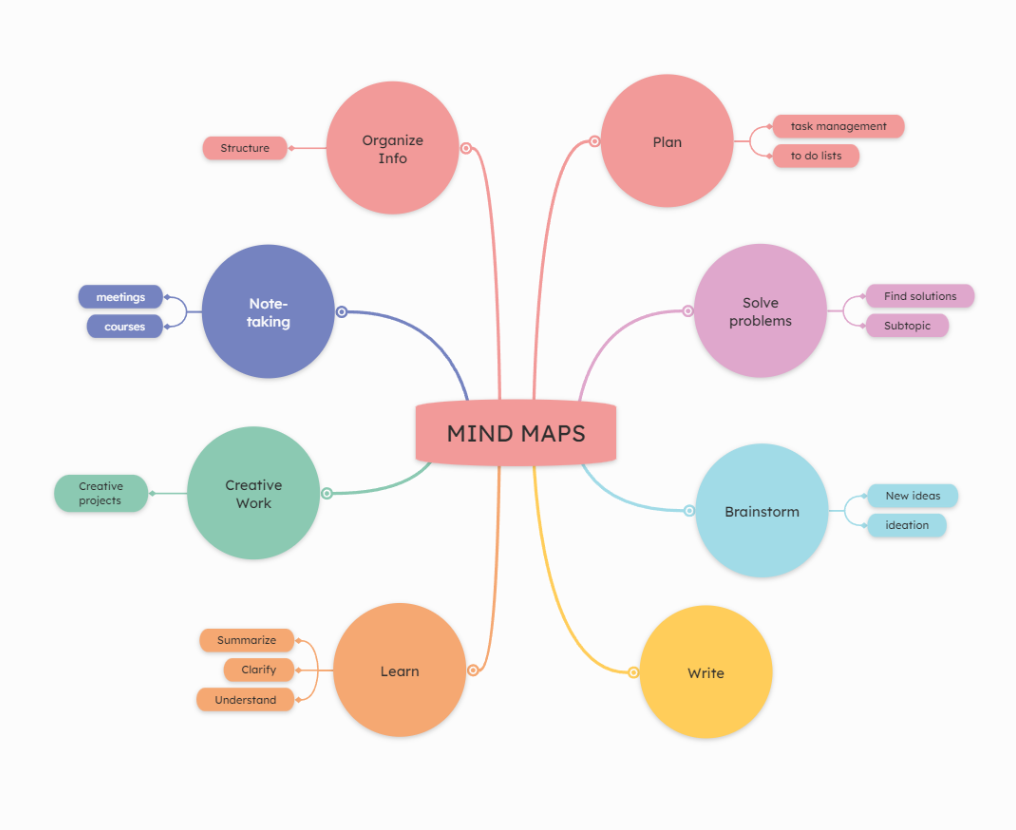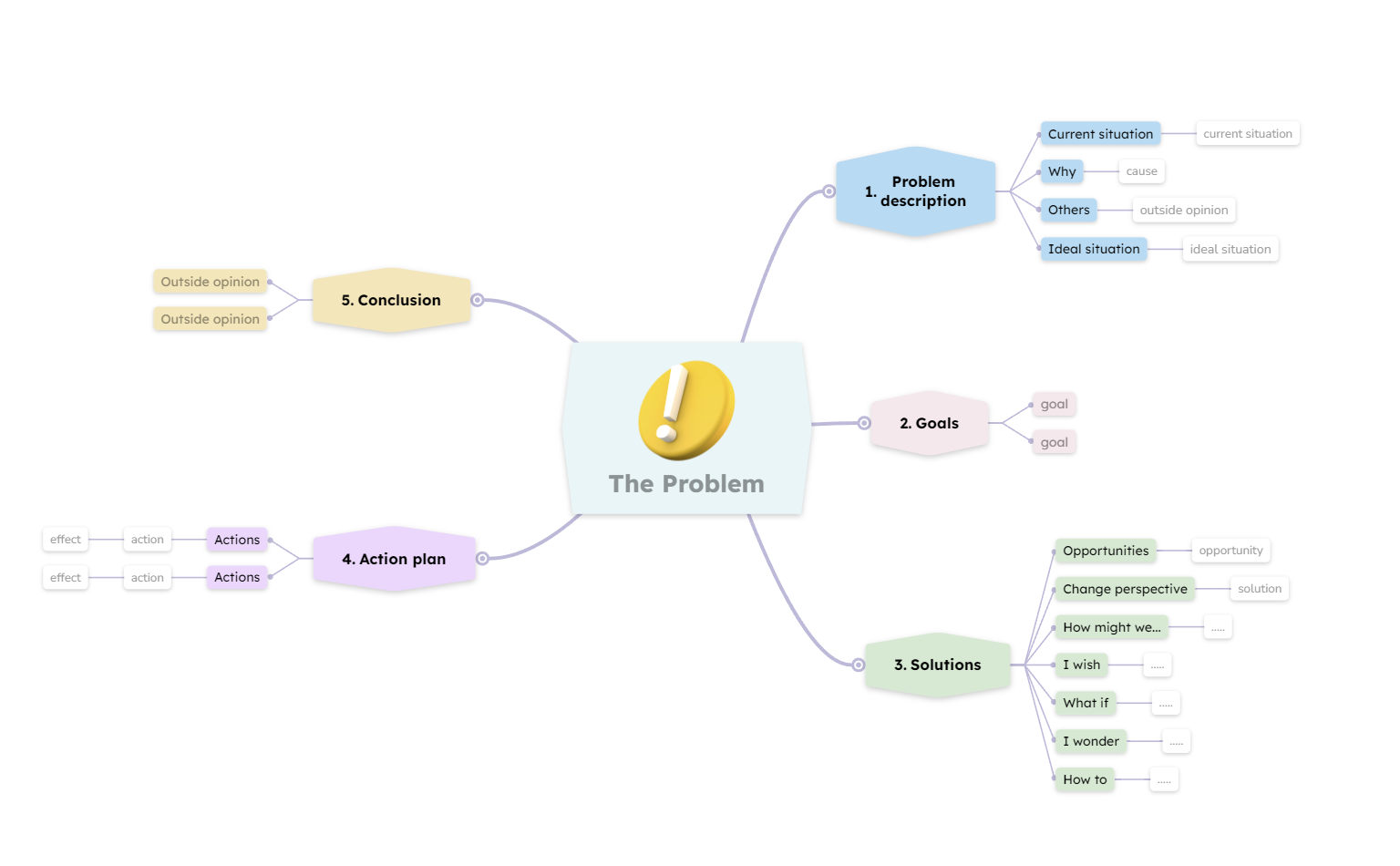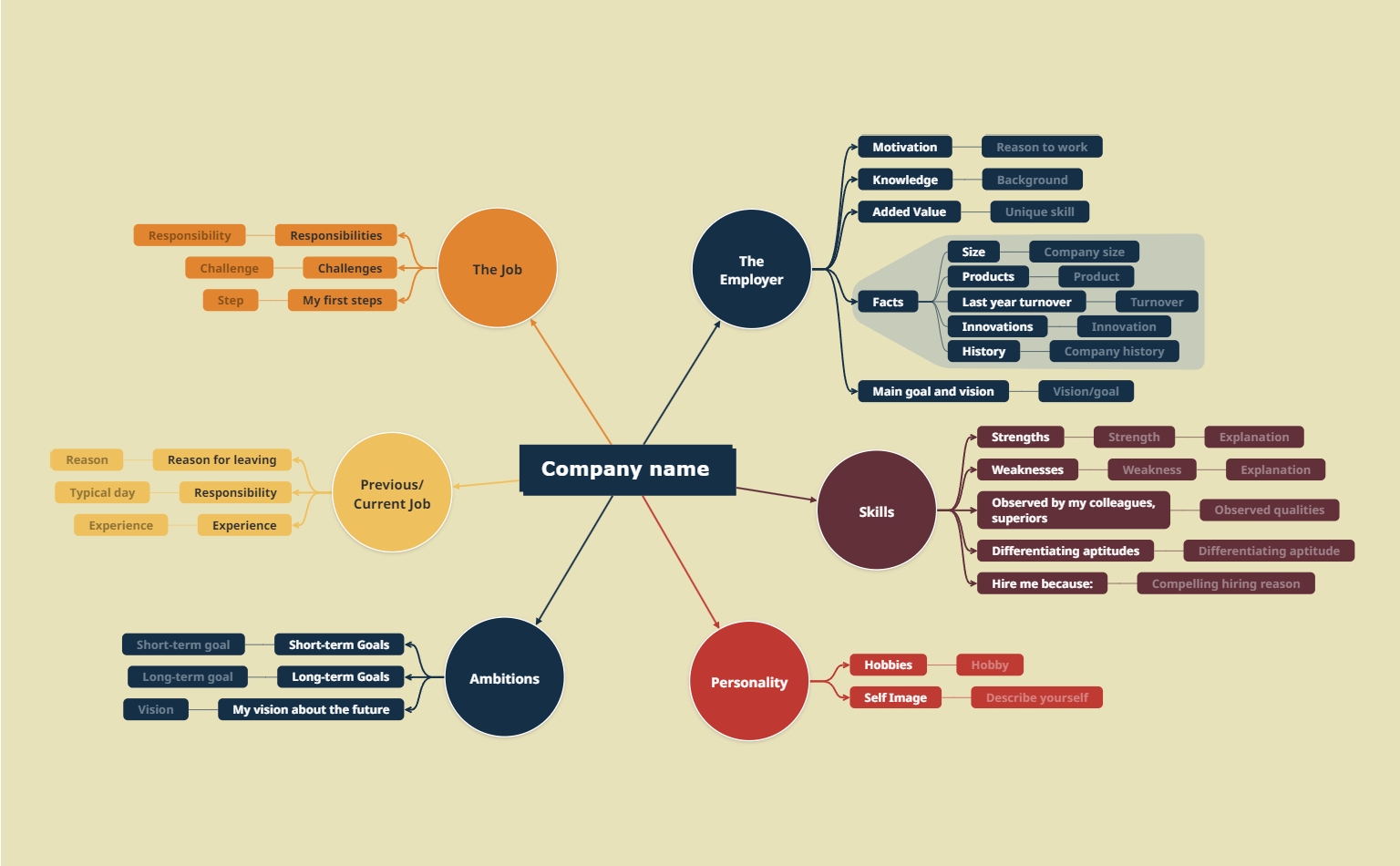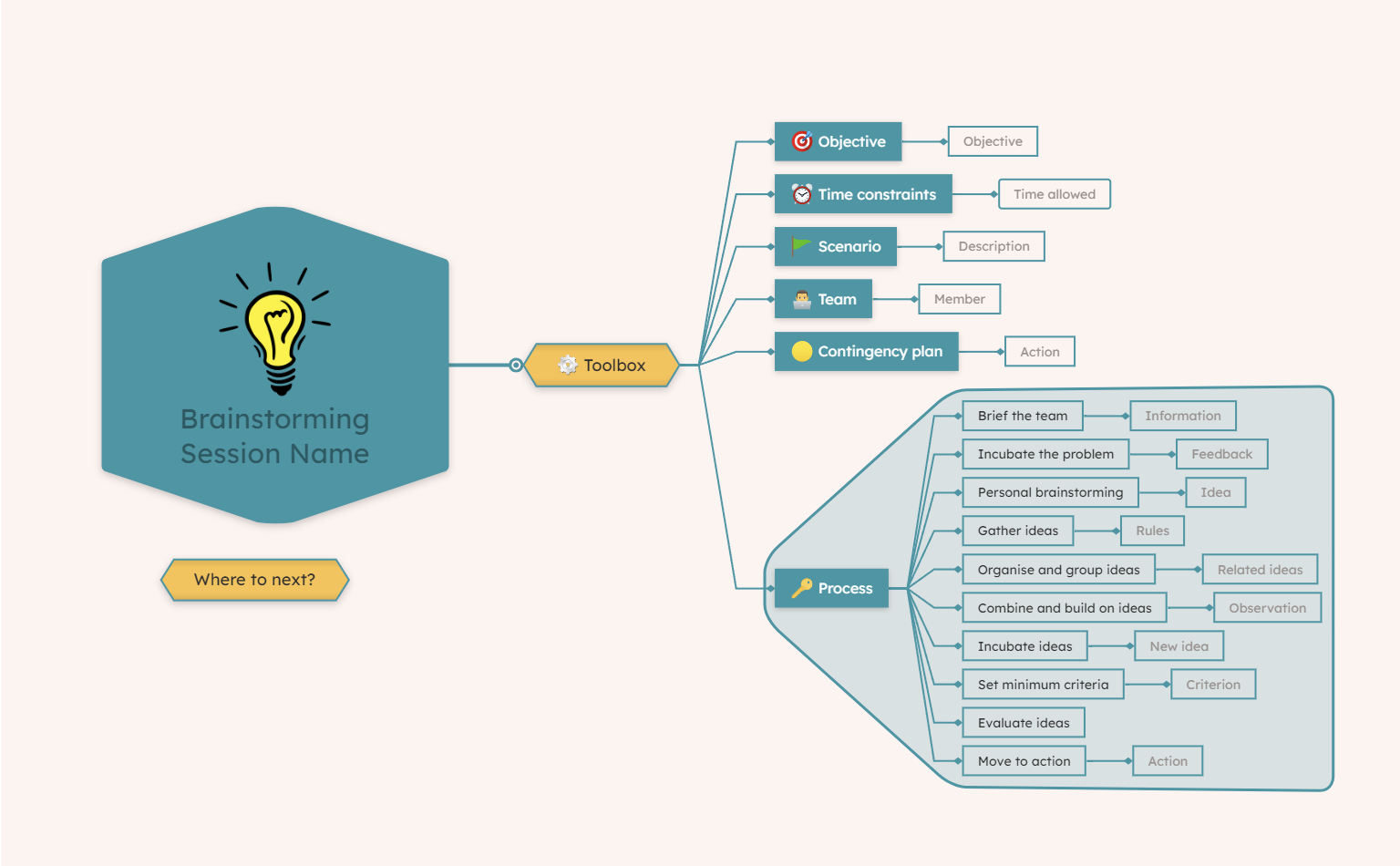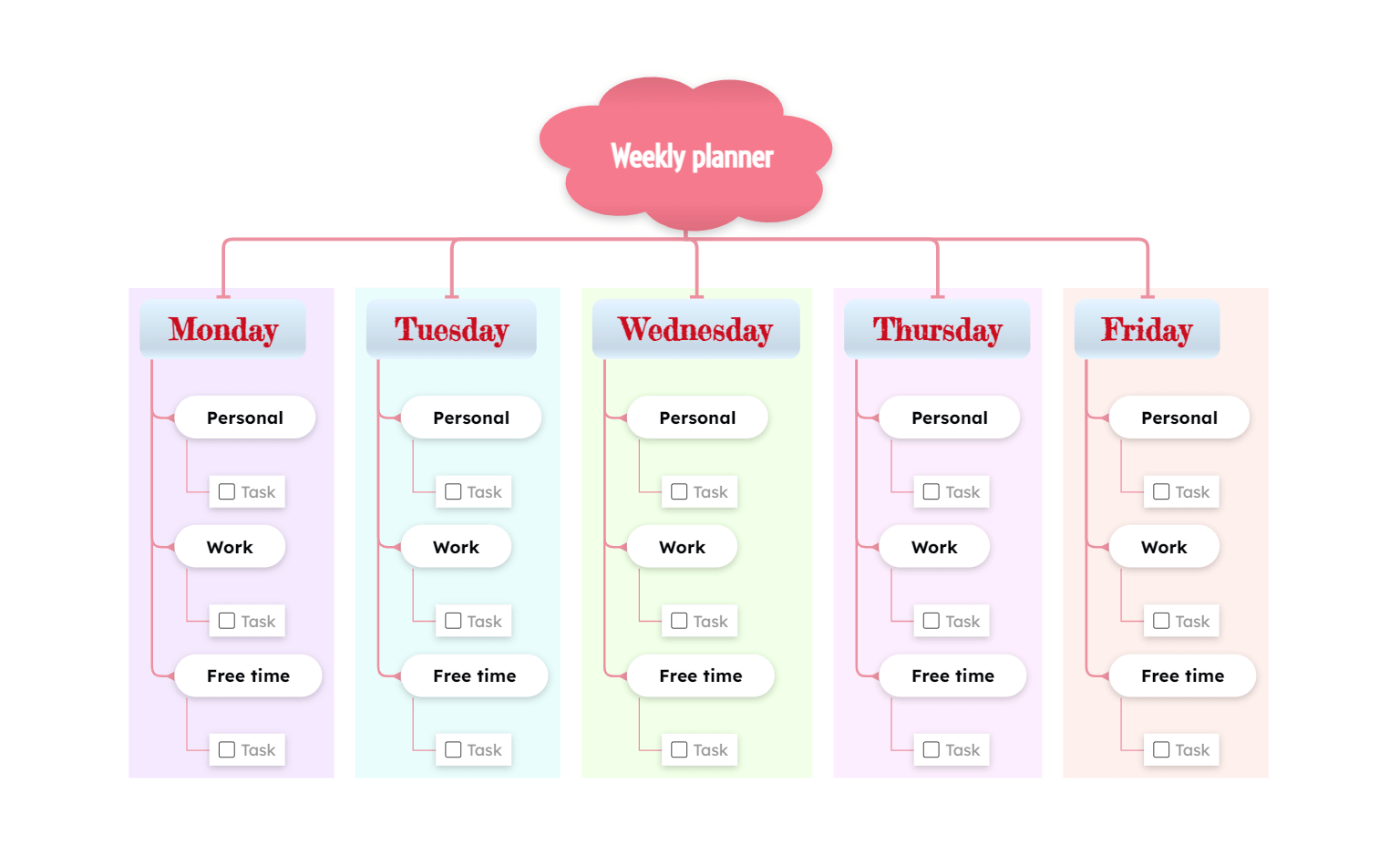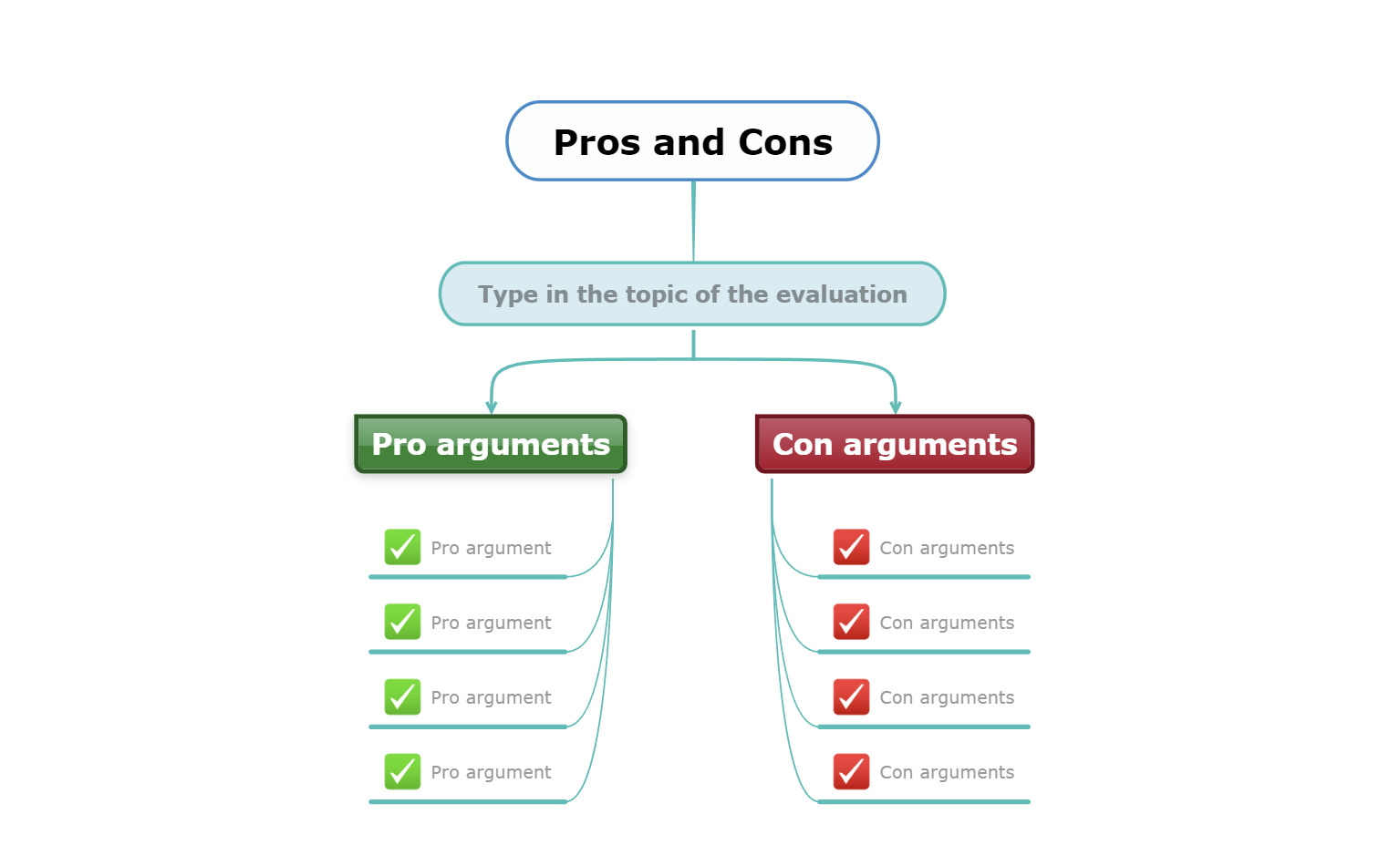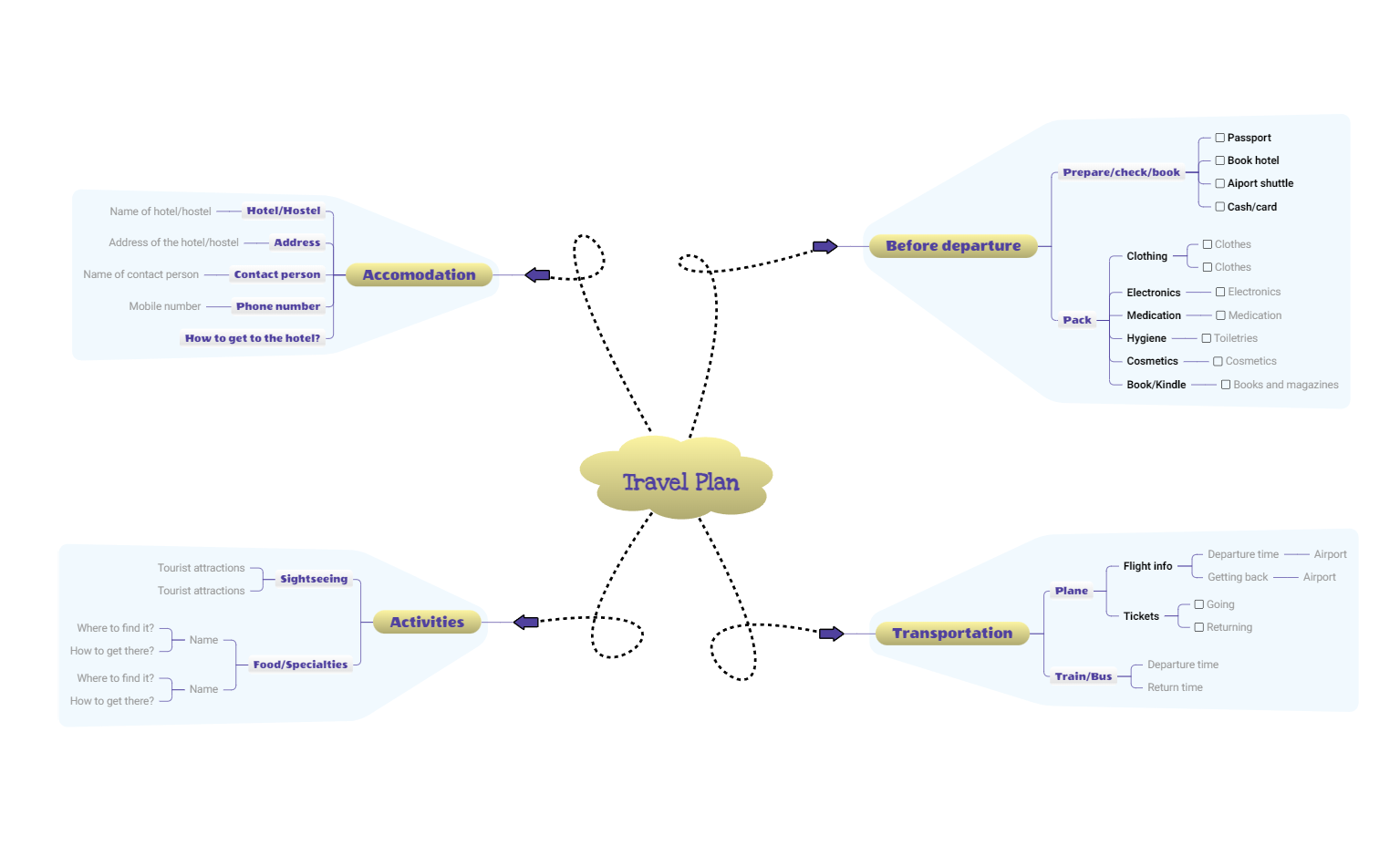The Concept of Mind Mapping
A mind map is also known as a “spider diagram” and it is a visual thinking tool. It is used to structure information and generate ideas.
Its power lies in its simplicity. Mind maps have a simple and hierarchical structure. They start from a central idea, and then they branch out key elements, which can branch out their own elements and so on.
All the information radiates from the center (main idea) to out (the connected ideas and sub-ideas).
Mind maps imitate the brain’s way of thinking: bouncing ideas. This is why they are a better option for organizing information than linear notes or plain text.
To understand a text, you have to read it. Reading is a two-step process; first, you interpret the sentences, then you create a mental image and hold it in your mind.
To understand a mind map, you need to visualize it. A mind map directly represents the mental image that you would have to create after reading a text. You get the gist of things in a single step, not two.
The information is not flat and lifeless but becomes interactive and worth exploring. It raises questions and makes us think. Visualization turns information into knowledge, insight, and action.
Compare these two ways of representing the same information:
As plain text:
Versailles is a French commune, capital of the Yvelines department in the Île-de-France region, known worldwide for its castle as well as for its gardens, sites classified by UNESCO as sites of outstanding cultural value to humanity. According to the 2015 census, the city has 85,771 inhabitants.
As a mind map:
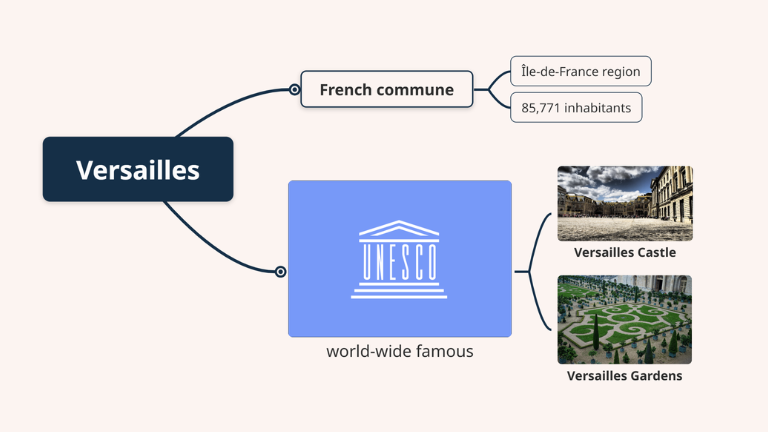
Mind map elements
A mind map consists of objects and features, which represent information. We can describe the anatomy of a mind map in two ways; by its features and by the features’ purposes when used in a mind map. Knowing the name of each feature will help you get started with mind maps. Knowing each feature’s purpose will help you create useful and meaningful mind maps.
Any mind map is made up of “topics”. All the elements in the mind map are topics, but some of them have special names. In mind mapping and in other related software, these topics are also called “branches”, “nodes” or “thoughts”.
The mind map's three main elements are:
The topic is represented by the central concept which is the parent concept to the ideas that are connected to it. Topics are usually represented by single words or images (or both).
2. Subtopics (occurrences)
The subtopics are the subideas connected to the topics. They are also called children. A mind map can have multiple levels according to the number of “generations” of subideas. Like the topics, they usually are composed of single words or short phrases which can be accompanied by images or icons.
3. Connecting lines (associations)
The connecting lines represent the association between a topic and a subtopic. Usually, they are curved lines, but they can also be straight lines.
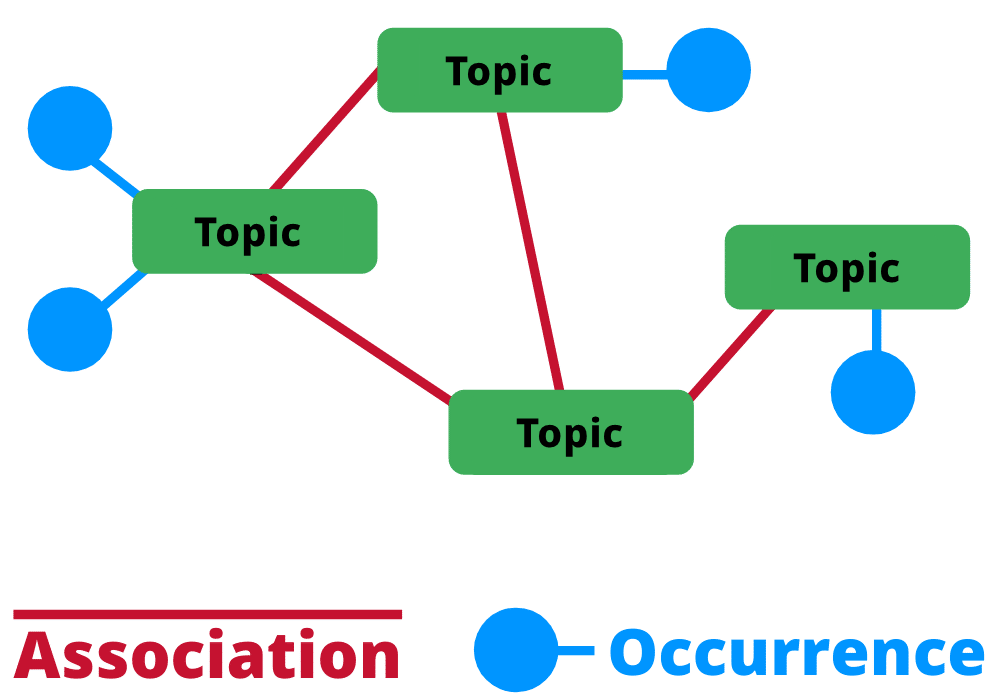
-
Every mind map has a Central topic, which is where the map starts. There is only one Central topic.
-
Attached to the Central topic are the Main topics. You can have as many main topics as you can fit into the mind map.
-
Attached to the Main topics are the Subtopics. Again, you can have as many as you like. They can also have subtopics of their own.
-
An unattached topic in the background is called a Floating topic. It belongs to the mind map, but is not joined to the tree.
-
You can draw Boundaries around a topic and its subtopics, to visually highlight them as a group.
-
You can draw Relationships between topics, to visually show a connection that crosses the tree.
Use mind maps in any way that suits you. But for them to be useful in the longer term, and for others to understand them, here are some suggested conventions that will make your maps easier to work with:
-
Give your mind map a clear title in the Central topic, or better still, state its purpose. It might be to collect information, capture a brainstorm, make a decision, make a presentation, or many other applications.
-
If your mind map makes a conclusion or describes a situation, present the main conclusions or summaries near to the center of the mind map, with the supporting evidence and detail below them.
-
If your mind map proposes new ideas, then show the big ideas near to the center, with the details underneath.
-
If your mind map organizes information, then try to get the main headings near the center and break them down into smaller groups, so that there is a natural way to “drill down” to the detail.
-
If your mind map is helping to make a decision, then state the decision near the center of the mind map and put the related factors and data underneath.
-
Use Floating topics to put an extra caption or legend on your mind map.
Many people think that mind maps and concept maps are the same things. However, there are some differences between concept mapping and mind mapping techniques.
Firstly, the concept maps have also a topic maps’ structure, but the difference is that the connecting lines are replaced with labeled arrows. The labels have the role to explain the relationship between the concepts.
Secondly, a concept map has a more flexible layout and it has many-to-many relationships. In other words, in a concept map presenting information is more detailed and the concepts are connected between each other.
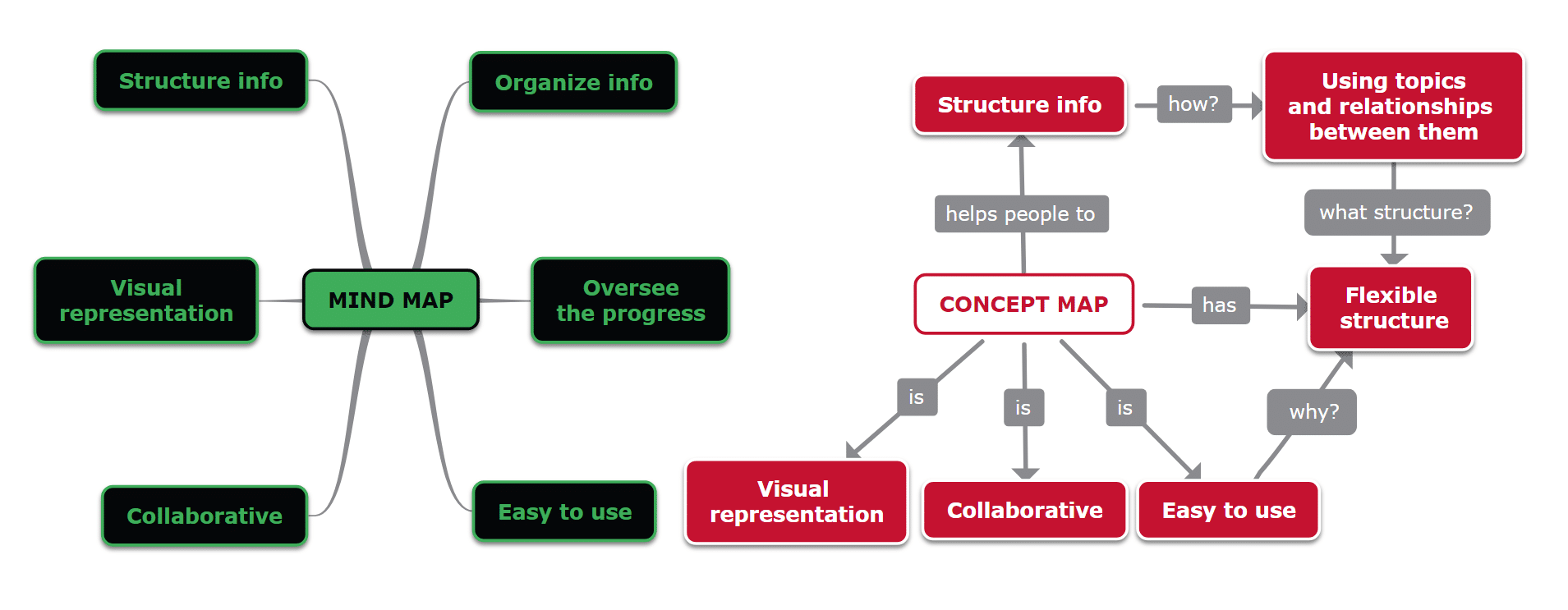
History of mind mapping
He mentioned and made the “mind map” term popular in 1974 on a BBC TV series when he talked about radial thinking.
He introduced this term, but the technique itself has roots from the 3rd century, when philosophers started to use graphic elements to diagram ideas, concepts, and thoughts.
When Buzan created this concept, he was inspired by big names of their history, such as Leonardo da Vinci, Albert Einstein, and later on by Joseph D. Novak (who created the concept maps).
Since it was discovered and until now, the process of creation has changed from drawing to digital building. Therefore you can create a mind map using pen and paper or advanced mind map software.
Traditional vs Digital mind maps
Compared to linear note-taking or plain text, presenting information into a diagram is much better. But which one is better: the traditional or the digital mind map?
How to make a mind map? You can create a mind map with ease on a blank page, using just your thoughts, a pen, and paper. However, a software will offer you significant advantages:
- You can easily edit the map by dragging and dropping topics, as your ideas come up, without squeezing topics.
- You can add images, videos and audio files, links, or icons.
- Many mind mapping software offer a big variety of templates.
- You can share your map and collaborate in real-time with other people. When you create a mind map online you store all your mind maps on a cloud and you can access them anywhere anytime.
What are mind maps good for?
Mind maps are powerful visual tools designed to help you organize, connect, and understand information more effectively. They mimic the way our brains naturally think—through associations, keywords, and visual connections—making them ideal for both individual and collaborative work.
Whether you're a student, teacher, business professional, or creative thinker, mind maps can help you:
- Summarize and organize information from various sources
- Brainstorm ideas and generate creative solutions
- Break down complex problems into manageable parts
- Take notes in a way that retains context and relationships
- Structure essays, reports, and presentations
- Create study materials or book summaries
- Plan projects, lessons, events, or strategies
- Think creatively while maintaining your focus
- Visualize tasks, priorities, and responsibilities
- Collaborate efficiently with your team
Mind maps aren’t just static diagrams—they’re interactive thinking spaces. Unlike traditional note-taking, where information can become linear and fragmented, mind maps help you see the big picture while keeping all the details connected.
When someone asks what a mind map is, you can confidently say: “It’s a visual thinking tool that helps you structure your thoughts, solve problems, and communicate ideas—just the way your brain does.”
There are countless mind map ideas to explore—whether you start with general templates or create your own for specific goals and purposes.
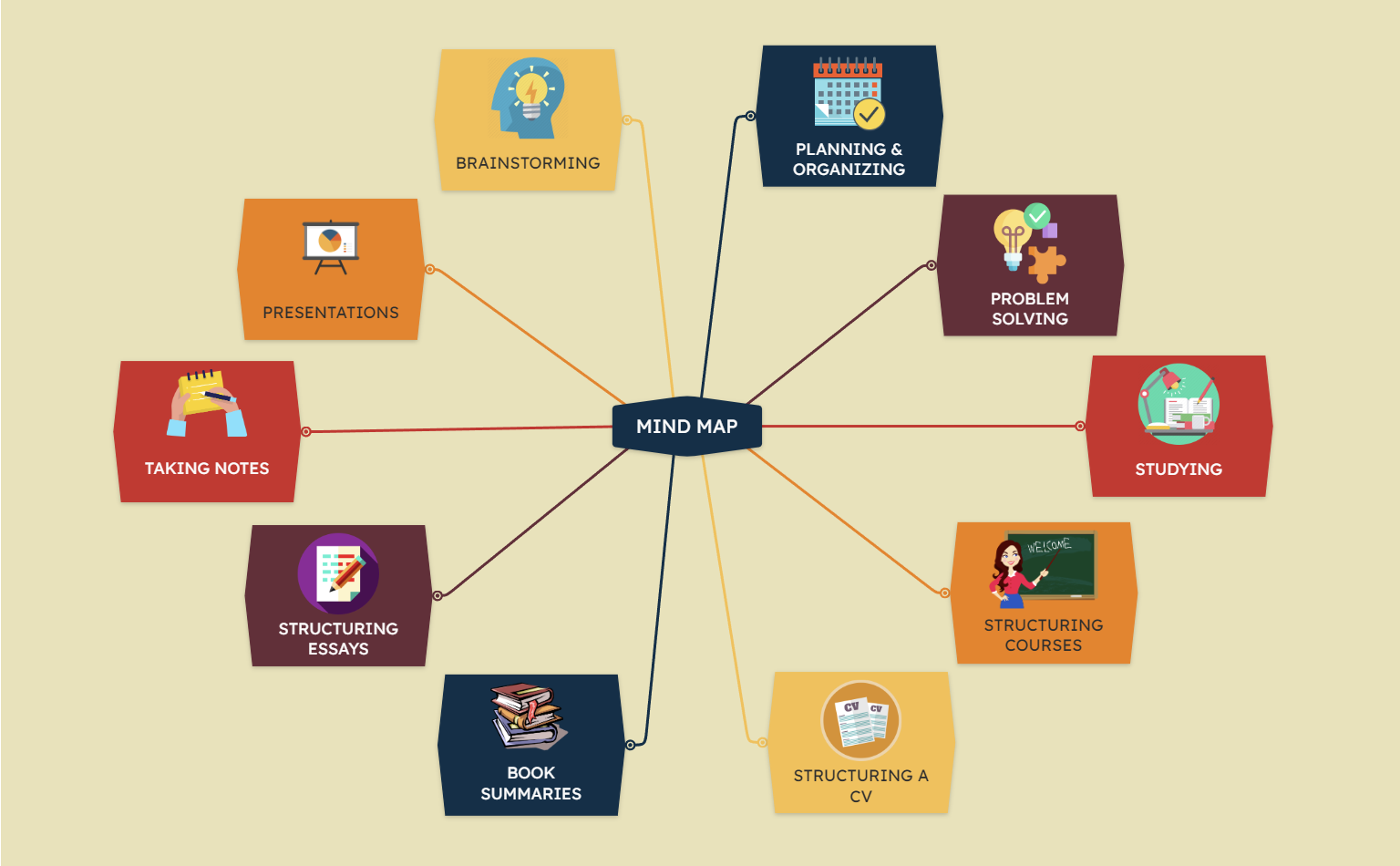
Common mind map types
While there are many different ways to use mind maps in a wide range of applications, there are a few common types of mind maps that are useful everywhere:
- Reference mind maps for keeping track of information
- Presentation mind maps for presenting or training
- Planning mind maps for creating plans
Reference mind maps contain information organized so that you can find it again easily. Many subjects can be broken down and represented this way. You can start by collecting ideas and facts, then reorganizing them into sections and subsections, so that you get a complete overview.
Use this mind map type for:
- Assembling documents or reports - the topic texts will become the section headings when you export the mind map to a word processor.
- Collecting resources - capture and organize resources such as web pages, companies, and information about people.
- Learning about a subject - build a mind map of information and facts to help you learn and revise.
- Keeping lists - keep track of detailed information in categories in different parts of your mind map.
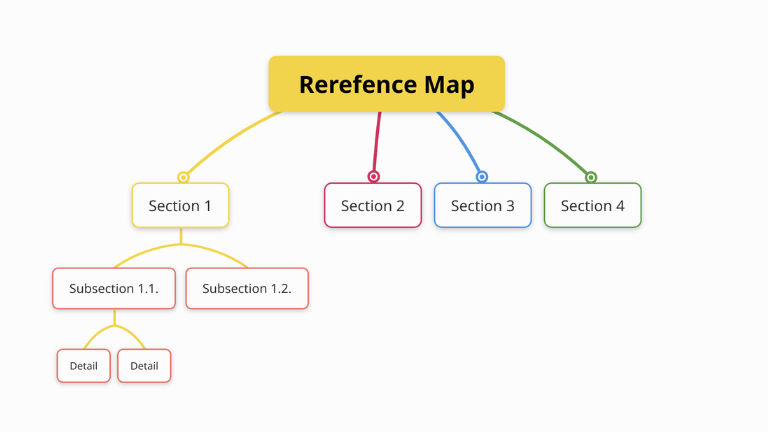
Presentation mind maps usually tell a story or make a point with a call to action. In contrast to the reference mind maps, these maps will support your talks by keeping the audience focused on your message.
Unlike a linear PowerPoint presentation, where your audience cannot see where you are headed or where you have been, the main messages are always in view, and the presentation pinpoints the context of those messages.
Many presenters like to have drama or surprises in their presentations, but your busy colleagues might not always appreciate this, and sometimes you can run out of time before getting to the key point. A mind map makes your message and intent very clear.
Use this mind map type for:
- Presentations where a decision or action is needed
- Training sessions
- Presentation handouts
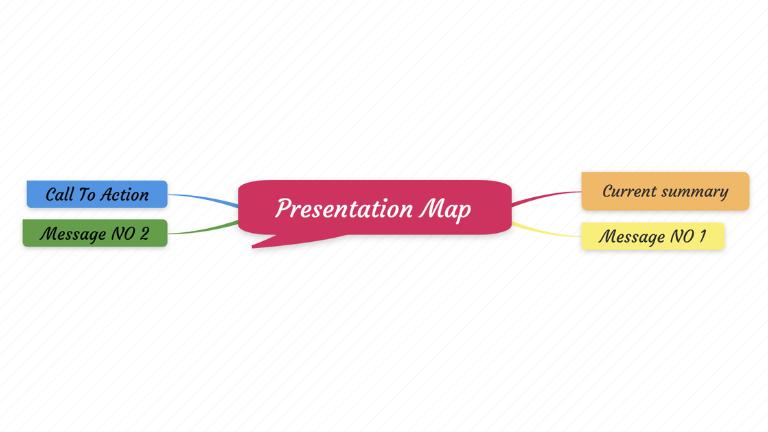
Planning mind maps are ideal when you’re organizing a project or goal. Start by placing the desired outcome at the center of your mind map. Then, structure all surrounding ideas as steps leading toward that goal—like arrows pointing at a target. The actions required to reach the outcome should build upon one another: tasks to be done at the beginning of the project will be positioned near the outer edges, while tasks scheduled for later stages will be closer to the center.
Mindomo lets you add task resources, start and end dates, and durations to topics that represent actions. You can also add information topics in the context of the actions where they are needed.
Use this mind map type for:
- Agreeing draft project plans
- Working out the order in which things need to be done
- Analyzing the root causes of a problem or issue
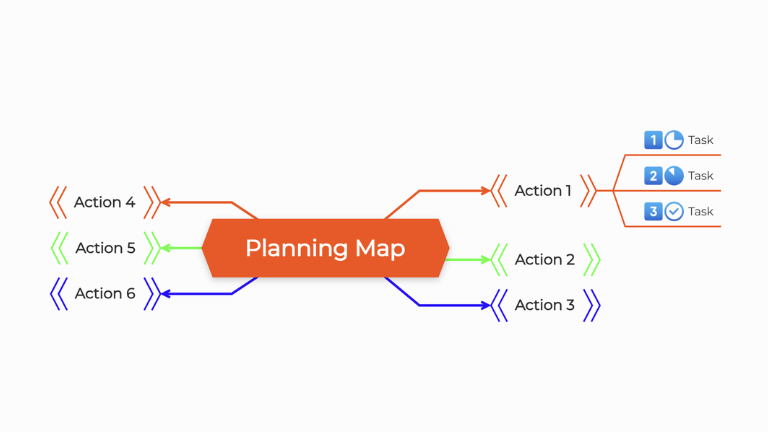
What is a mind map template?
Mind map templates are prefilled mind maps containing placeholders you can fill in with your own information. There are also guidelines explaining how to fill each topic and suggesting ideas.
You can find a wide range of templates, such as:
Benefits of mind mapping
Mind mapping has a wide range of benefits for education, business, and personal life.
Better understanding
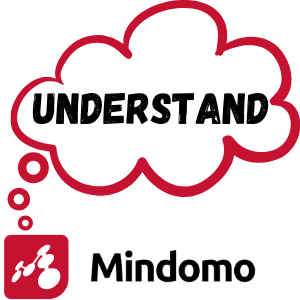
The brain directly comprehends the concepts and the connection between them, and it doesn’t have to interpret first, as it does with plain text. There is research showing that students who use mind mapping have better grades, as explained in Johns Hopkins’s study.
Better memory
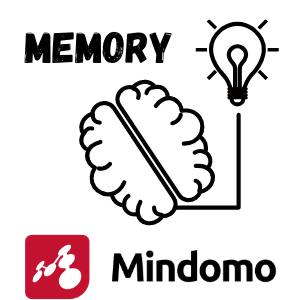
All the visual elements increase the retention of information, which is why educators use mind maps for kids and students for education purposes.
Creativity
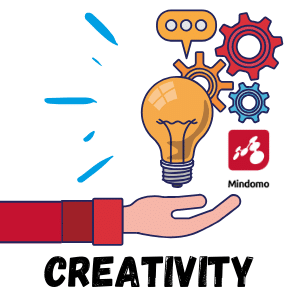
All the visual elements increase the retention of information. This is one of the main reasons why a mind map is a diagram often used for education purposes.
Better management
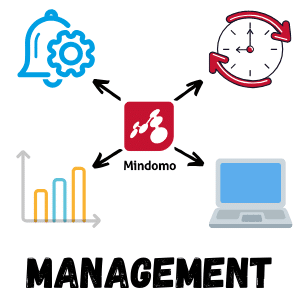
You can beat procrastination when you have everything planned. The main advantage is that you can focus on a specific branch of a mind map with tasks while always having the overview in front of your eyes. This way you won’t lose sight of the main goal when you focus on the details.
Who should use mind maps?
Mind maps are for everyone—from students and teachers to professionals and creatives. Whether you’re organizing ideas, managing projects, studying for exams, or planning your next big move, mind maps help simplify complex information and boost productivity through clear, visual thinking.
Educators
The main benefits of mind mapping in education can be clearly defined through collaborative learning, creative problem solving, effective organizing of ideas on diagrams, and instant visualization of information through presentations straight from the map.
Join thousands of educators who are using mind mapping as their go-to teaching tool to improve student productivity and performance:
- Encourage students to work together on visual projects
- Create diagramming assignments that can be easily accessed online
- Organize online resources and learning concepts across the curriculum
Students
Don’t get left behind—discover how mind mapping can unleash your creativity while studying and help you develop your own unique way of presenting information:
- Design fun and engaging study guides to improve memory retention and achieve higher test scores
- Take quick, organized notes during class and easily add comments on the way
- Stay on top of your coursework by linking your syllabus directly to your diagram and tracking assignment deadlines
- Collaborate in real time with classmates on creative group projects
- Deliver dynamic presentations straight from your diagram to showcase your ideas
- Research online journal articles and resources, then add them to your diagram using Mindomo Bookmarks or direct hyperlinks
Entrepreneurs
Entrepreneurship thrives on innovation, clarity of vision, structured execution, and the ability to pivot quickly. Mind mapping supports entrepreneurs by transforming scattered ideas into focused strategies, providing a clear path from concept to launch and beyond. Whether you’re building a startup or managing a growing business, visual thinking can give you a competitive edge:
- Build a lean business plan with branches for key sections (market, product, team, funding)
- Define short- and long-term goals using a clear hierarchical structure
- Visualize product or service development stages
- Share your work with co-founders, advisors, or team members in real time
- Centralize documents, links, and tasks inside your maps for remote teamwork
- Co-develop product iterations or marketing campaigns in a visual format
Consultants
Successful consulting relies on the ability to think laterally, plan strategically, assess projects efficiently, and communicate effectively with clients.
Mind mapping supports this process by turning complex information into clear, actionable visuals—helping consultants stay organized, focused, and innovative:
- Organize relevant resources regarding your client’s organization and projects
- Build flexible client profiles directly within diagrams
- Anticipate discussions by preparing relevant questions in advance
- Present ideas clearly by using visual examples and the built-in presentation mode
- Create assessment criteria maps to guide project evaluation
- Develop case studies by mapping pros and cons for easy comparison
- Collaborate live with colleagues and clients on shared maps
- Share updates and key insights post-meeting with visual clarity
- Invite partners to co-develop service improvements or contribute best practices
Managers
Whether leading teams, aligning projects with organizational goals, or optimizing workflows, managers thrive on clarity and structure.
Mind mapping offers a visual framework that enables managers to plan, organize, and execute with precision—empowering their teams and maximizing results:
- Define team goals and company priorities using a clear visual layout
- Map out team roles, project milestones, and deliverables in one central diagram
- Delegate tasks visually and monitor progress directly from your map
- Use Gantt chart integrations to track timelines and dependencies
- Keep track of KPIs and performance metrics with structured, visual dashboards
- Present updates, roadmaps, or progress reports directly from your diagrams—they’re
- Analyze challenges with SWOT or fishbone diagrams
- Brainstorm and evaluate multiple solutions with your team in collaborative mode
Lawyers
In a profession where clarity, logic, and persuasion are paramount, mind mapping offers a practical, visual approach to streamline legal thinking and communication:
- Collect and organize legal precedents, statutes, and case notes in a single, navigable map
- Link documents, references, and citations directly to relevant subtopics
- Structure your legal theories and supporting evidence in a logical hierarchy
- Keep track of ongoing research and sources using bookmarks and comments
- Outline examination questions and organize deposition notes efficiently
- Identify weaknesses in your case and brainstorm counterarguments or alternative strategies
- Map out negotiation paths or litigation timelines with clear branching logic
- Use the built-in presentation mode to deliver structured, compelling visual summaries for courtroom
Researchers
Research is a process of inquiry, discovery, and communication. Diagramming helps researchers visualize complexity, make meaningful connections, and keep their work organized and adaptable throughout every stage:
- Design your research framework by outlining objectives, hypotheses, and methodologies
- Categorize key authors, theories, and concepts in a centralized visual space
- Create comparison maps for theoretical frameworks or previous studies
- Annotate articles and highlight relationships between ideas or contradictory findings
- Use hyperlinks and bookmarks to manage PDFs, databases, and notes
- Link relevant files, forms, or institutional review documents to appropriate sections
- Structure funding proposals and grant application details with clarity and hierarchy
- Prepare poster sessions, papers, or thesis chapters from your structured diagrams
- Collaborate with co-authors or advisors in real time on shared visual plans
All Creative Individuals
Mind mapping is a creative space where you’re never too old to play with your ideas and never too young to unlock your full potential.Who are the creative ones among us?
- Children are naturally creative, continuously discovering the world through play, curiosity, observation, imitation, and hands-on experimentation.
- Adolescents express creativity as they navigate rapid mental, emotional, and physical changes. They question and reinterpret the world around them to find meaning and direction.
- Adults demonstrate creativity by developing new perspectives, solving problems independently, and making informed decisions that shape their environment.
- Seniors embody creativity as they reflect on a lifetime of learning, drawing from experience to discern what truly matters—what to pursue, invest in, and stand for.
Creativity is more than just a mindset—it’s an attitude of hope. It’s the belief that any challenge, idea, or activity can be transformed into a wellspring of possibility.
Ways to use mind maps to turn your simplest ideas into lifelong projects:
- Brainstorm your most meaningful experiences, goals, and accomplishments
- Define your milestones using short, clear statements
- Develop a personal growth plan step-by-step
- Use visual layouts to highlight your strengths and reflect on your weaknesses
- Gather inspiration by inserting videos, images, and audio files into your diagrams
How to create a mind map
You can create a mind map from scratch or use mind map templates. If you choose the first option, get inspired by this tutorial which shows the step-by-step creation process.
When you create your map follow these simple tips to build a perfect one:
- Use simple words, such as keywords or short phrases, and avoid writing full sentences.
- Add images, videos, or icons – mind mapping is all about the visuals; use the maximum potential of the visual representations, and don’t limit yourself only to text.
- Use a central image when you start your map to stimulate your imagination and generate new ideas.
- Use different colors to highlight and differentiate different topics, categories, or subjects. It will be easier to remember the information.
- Differentiate each level of the diagram by writing it with a different font size (starting from the biggest size in the center and decreasing the size toward the edges.
Do I need to learn how to mind map before using Mindomo?
No — you will gain value and benefits from Mindomo simply by using it in a way that feels natural to you. It’s far more important to know what you want to achieve than to be an expert in any specific technique.
Many people create mind maps without a clear purpose, but if you’re focused on reaching a specific goal, your maps will guide you forward much more effectively.
If you plan to collaborate with others and share your maps, the only thing you’ll need to agree on is how to interpret the information within — distinguishing between ideas, decisions, actions, and priorities. Mindomo offers a rich set of visual tools that make this easy.
Get inspired by Mindomo’s Public Map Gallery
There are many mind mapping tools out there—some overloaded with features you’ll never use, others too limited to support your workflow. Mindomo strikes the perfect balance, offering a carefully selected set of features ranging from the simple to the advanced, so you can focus on your work—not the tool.
Take a moment to explore our Public Map Gallery. Try to guess what each author aimed to achieve with their map—it’s often not immediately obvious. By analyzing how others organize their ideas, you’ll quickly learn what works well, what doesn’t, and how to improve your own maps.
Ask yourself: What would have made this map easier to understand? Be sure to apply those insights to your own creations.
With platform flexibility, fast setup, and a short learning curve, Mindomo helps you get started quickly—and stay focused on what really matters.
